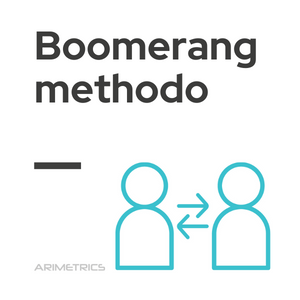
Definition:
The boomerang method is a sales technique used by salespeople to effectively handle customer objections. This approach is based on the premise that objections can be transformed into opportunities that encourage the customer to make an immediate buying decision. Rather than rejecting the objection or engaging in conflict, the salesperson rephrases the objection in a way that highlights the urgency or necessity of the product or service. For example, if a potential customer expresses that he or she cannot afford to purchase a product, the salesperson might respond with a provocative question, such as, “But can you afford NOT to buy it?”
This strategy seeks to get the customer to reflect on the implications of not making the purchase, thus turning the objection into an argument in favor of the action. The boomerang method is based on several basic rules that salespeople must follow to be effective, including empathizing with the customer, avoiding confrontation, identifying other possible objections, and communicating respectfully without disqualifying the customer.
How to apply the boomerang method
The boomerang method is based on several basic rules that salespeople must follow to be effective:
- Empathize with the customer: Understand and validate their concerns.
- Never argue with him: Maintain a positive and constructive approach.
- Find out if that objection is the only one: Investigate if there are other reasons preventing the purchase.
- Do not make him/her see that he/she was wrong: Avoid confrontations and maintain respectful communication.
Examples of the use of the boomerang method
The boomerang method can be applied in a variety of sales situations. For example, if a customer expresses that the price is too high, the salesperson might respond, “I understand that the price may seem high, but have you considered the cost of not investing in this product and losing out on the benefits it offers?” This type of response not only validates the customer’s concern, but also leads them to reconsider their decision from a different perspective.
Another example might be if a customer says he needs more time to think about it. The salesperson might respond, “How about instead of waiting, we secure your purchase today and guarantee you a better price or a special offer?” In this way, you turn indecision into an opportunity to close the sale.
Benefits of the boomerang method
The use of the boomerang method offers several benefits for both salespeople and customers. For salespeople, this technique can result in increased conversion rates by proactively addressing objections and turning them into sales pitches. It also fosters a more positive and collaborative relationship with the customer by focusing on their needs and concerns. For customers, the boomerang method can lead to a more satisfying buying experience. By feeling that their objections are heard and valued, customers can feel more confident in their buying decision. This can not only lead to greater customer satisfaction, but also to greater long-term brand loyalty.
Boomerang method applications in digital marketing
The boomerang method has been effectively adapted to the digital marketing arena, where interactions with customers are increasingly dynamic and personalized. Here are some of the most common applications of this technique in digital marketing:
- Handling objections in email marketing campaigns: In email campaigns, marketers can anticipate objections that subscribers might have, such as price or the need for more information. Using the boomerang method, responses to these objections can be included in emails, transforming them into reasons to act, such as special discounts or testimonials from satisfied customers.
- Chatbots and customer service: Chatbots can implement the boomerang method by interacting with users in real time. If a customer expresses doubts about a product, the chatbot can respond in a way that turns that doubt into an opportunity to highlight the advantages of the product or service, encouraging the customer to proceed with the purchase.
- Content marketing: In creating content, such as blogs or social media posts, marketers can address common objections of potential customers. For example, an article can present a common objection and then use the boomerang method to offer a perspective that motivates readers to consider the benefits of the product or service.
- Landing pages: Landing pages can benefit from the boomerang method by including sections that directly address visitor objections. This can include frequently asked questions (FAQ) where objections are rephrased and solutions or benefits are presented that encourage conversion.
- Retargeting and remarketing: Using retargeting strategies, ads can target users who have shown interest in a product but have not completed a purchase. These ads can boomerang by directly addressing the reasons for hesitation and presenting arguments that encourage action, such as limited offers or testimonials from other customers.
- Webinars and online events: During webinars, presenters can use the boomerang method by addressing objections attendees may have about the product or service. By responding to these objections in a way that highlights the benefits and urgency, you can increase the conversion rate of attendees to customers.
